Key in a search term below to search our website.
Key in a search term below to search our website.
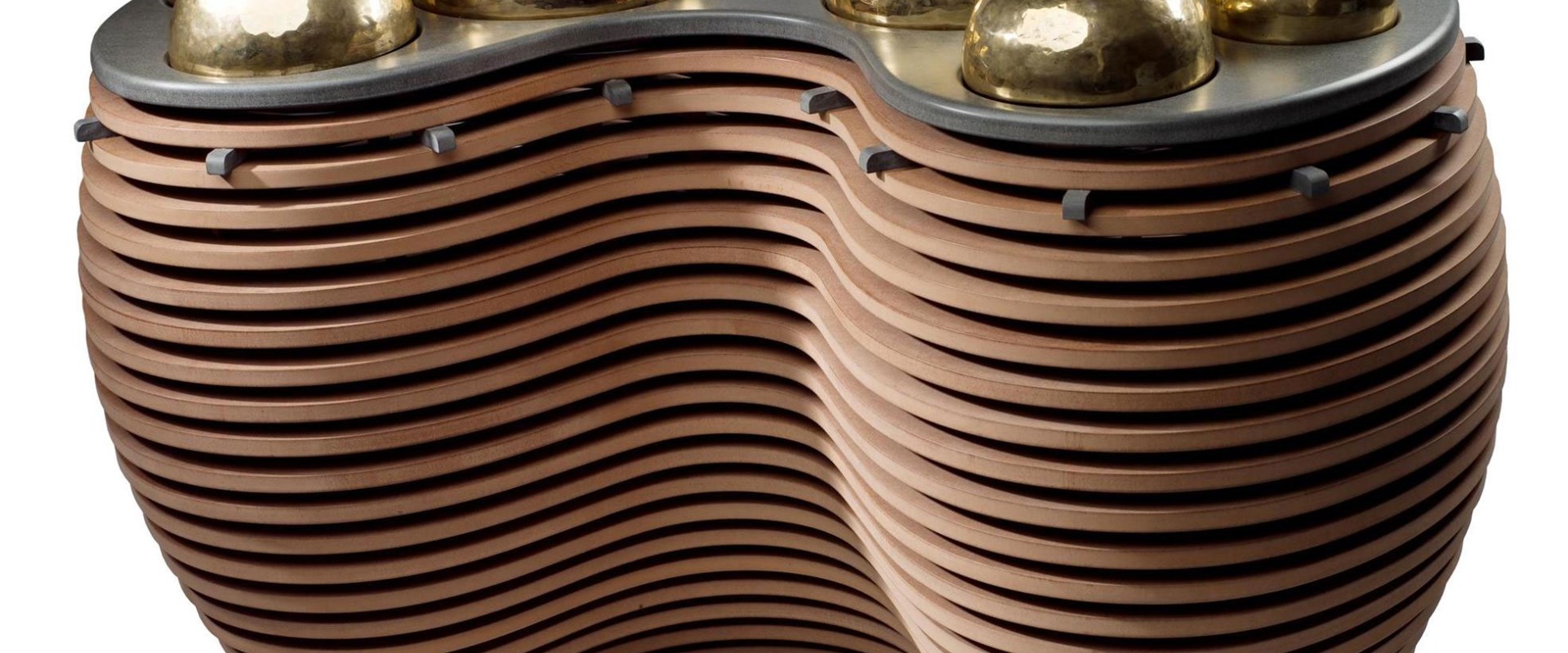
These four unique instruments were specially created for Performance and Lives gallery at the National Museum of Scotland by internationally renowned composer and artist Victor Gama.
Date
2008
Made in
Colares, Portugal
Made by
Victor Gama
Museum reference
On display
Tipaw and Vulk are displayed in Performance and Lives, Level 3, National Museum of Scotland.
Did you know?
Tipaw was inspired by Victor Gama's visits to Edinburgh. "Every time I visited the museum," he says, "I would pass Edinburgh Zoo on the way from the airport. So I thought about a tiger escaping from the zoo and hiding overnight in the Museum. It prowls around the halls until the morning, when it leaps upon a visitor, leaving these paw prints behind."
Performance and Lives is one of six new World Cultures galleries in the redeveloped National Museum of Scotland. When we were planning these galleries, we knew that the musical instrument collection was an under-researched and under-used part of the collections and so it seemed clear that we should develop a gallery looking at music and performance.
As well as showcasing our collection, we wanted visitors to hear the instruments on display, which range from classical to folk and hail from all parts of the world. We also wanted to provide visitors with the chance to play musical instruments in the gallery, to express and experiment with their own creativity.
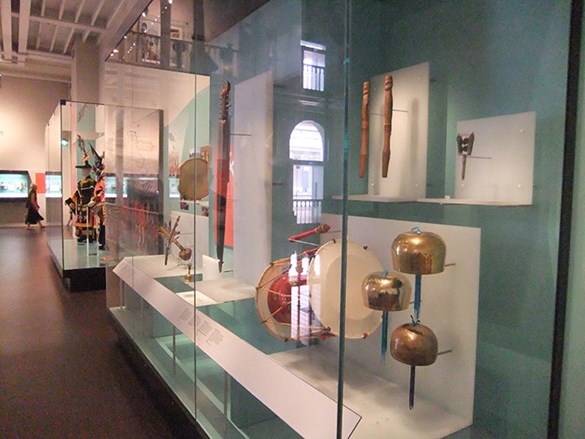
Above: the Performance and Lives gallery.
Now, in the gallery, visitors can listen to over 50 recordings, the majority of which were made by the American ethnomusicologist Jean Jenkins (1922-1990), and can send themselves mixed tracks as MP3 files, using the World Music Composer. Visitors can also play four new musical instruments designed and constructed by the musician, composer, artist and instrument maker Victor Gama. These instruments were commissioned for the collections and are unique to the National Museum of Scotland.
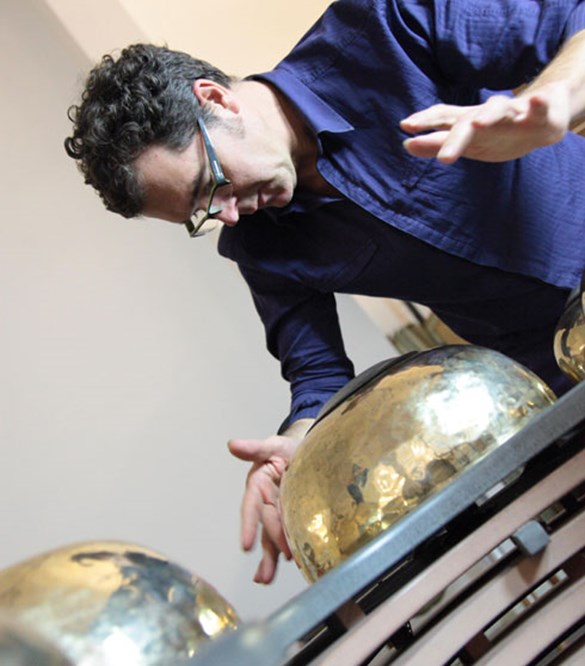
Above: Victor Gama playing Tipaw.
Victor Gama is Angolan, of Portuguese descent, and lives and works out of Portugal. He uses his dual heritage as a starting point for his compositions and musical constructions. As a performer and composer, Gama creates his own instruments using a variety of materials, ranging from traditional sources, such as gourds, to carbon fibre, and he incorporates all manner of design and fabrication techniques.
Gama has a history of working with museums, most notably the Lower East Side Tenement Museum in New York, and his compositions and instruments have been played by such groups as the Kronos Quartet.
For Gama, instruments evolve, and he believes that for non-classical and non-western musical forms, there is a greater degree of innovation in instrument making than is acknowledged. Each time an instrument is re-made, it incorporates the responses of the instrument maker and player into the prior version. The Museum invited Gama to use this creative method to explore the sounds of National Museums Scotland’s collection of musical instruments gathered from Africa, the Middle East, East and Central Asia.
The production process of the instruments involved visits to and from Portugal. Gama visited the Museum several times, for research and meetings, and took the opportunity when he was travelling elsewhere to collect the right materials for the instruments. He took photographs, sent initial designs and then refined them in discussion with curatorial staff, taking into account the instruments’ need to be accessible and robust.
From his research into our collection, Gama created four new instruments entitled Tipaw, Tartul, Tonal Matrix, and Vulk. Each of these instruments responds to a theme explored in the gallery, as well as drawing inspiration in terms of construction and materials from our collections. Each comes with a story concerning its sound and origin.
From above Tipaw looks almost like tiger paws; its body is a round kidney shape, made of layers, and is both solid and somewhat transparent. For Gama it looks like the ground squashed under the tiger paws. with the ridges a sign of his impact.
Part of the inspiration was commuting from Kolkata to Edinburgh. Kolkata is where the Tibetan ringing bowls which make the ‘pads’ of the paws were collected, and it is often the jumping off point for visitor wishing to see Bengal tigers. Gama participated in British Council events in Kolkata and collected the ringing bowls himself, rather than have them shipped; this proved more economical and allowed him to select those that he thought be would especially tuneful. When Gama came back from Kolkata he passed by Edinburgh Zoo, and the connection was made in his mind.
On Tipaw, the ringing bowls are used differently than is traditionally the case: they are struck like bells from the side, and this creates an extraordinarily tuneful, ethereal and sustained sound, best heard when the ear is close to the bells.
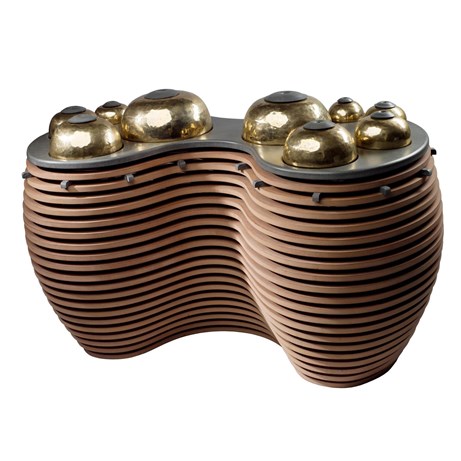
Above: Tipaw.
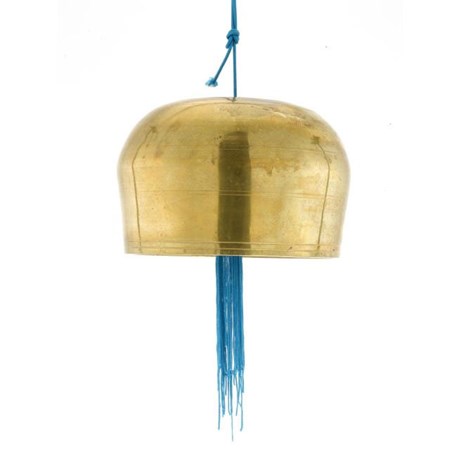
Above: Bell from Korea.
Tartul looks like a slightly unsettling spider with spindly legs. It uses gourds on the bottom to act as resonators. These were collected by Gama when he visited Colombia. Inspired by the African trough zithers and xylophones in the Museum’s collection, plucking the steel ‘strings’ gives a harmonious though slightly raw sound, Like Tipaw, Tartul can be played by two people simultaneously.
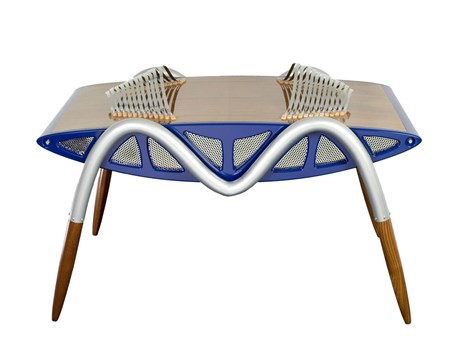
Above: Tartul.

Above: A xylophone from our collections.
The Tonal Matrix is played vertically. This instrument has sixty keys that are plucked, arranged in four groups according to a pentatonic scale. It generates clear and delicate sounds that can be played in quick succession with up to three other people. The Tonal Matrix evokes the sounds and the construction of African thumb pianos, which are played on the move. The design of Tonal Matrix plays with this idea of movement; in its vertical design the body of the instrument is on four steel legs. This makes it look animate, as if it is just about to walk off.

Above: Tonal Matrix.

Above: A thumb piano from our collections.
Finally, Vulk has dramatic colouring with red and orange stripes, evoking an image of lava, so it looks like an erupting volcano. Some of the detailing found in the design of the zithers in the collection – the open star, for example – is a frequent detail on musical instruments. Vulk is composed of cymbals stacked on top of each other. When played they can give distinct percussive sounds, and if played enthusiastically can sound more like a roar.

Above: Vulk.

Above: A zither from our collections.
The Museum was very lucky to be able to work with an internationally known musician and artist and the instruments are a phenomenal addition to the World Cultures collections, demonstrating how new instruments can be developed using archival recordings and folk traditions, whilst also showing how innovation in music is a constant. Gama sees music as a dialogue and all the instruments were created for collective use. Made from a mix of natural and high-tech materials, they are unusual, shiny, colourful, visually compelling to invite the visitor to tap and pluck, to make sounds and explore.